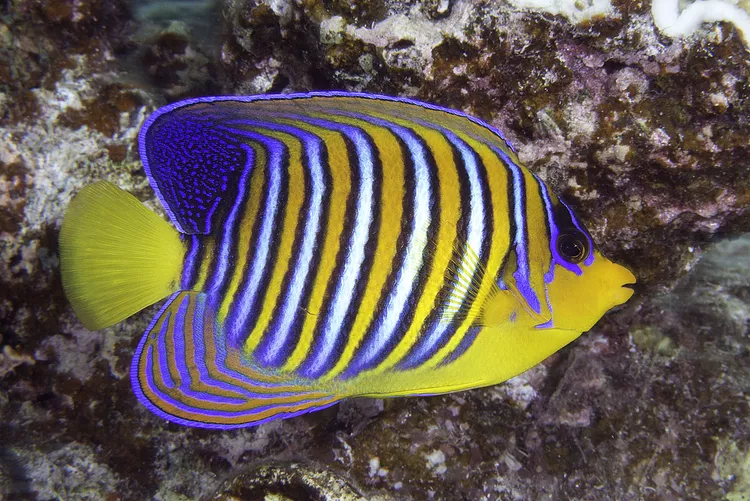
Size
It can grow up to 15 inches in length.
Physical characteristics and behavior
The common Regal Angelfish have margins that are blue and black with orange and white stripes. Their dorsal and anal fins have orange and blue stripes, and their backs have black spots. They have yellow tails. white and orange stripes with borders in blue and black. Some Regal Angelfish in the Pacific have blue heads, while others in the Indian Ocean have yellow ones; yet more have a combination of these and other colors on their bodies. This species’ food changes as they become older to incorporate various colony invertebrates like sponges, bryozoans, and hydroids.
Habitat
Adults require a tank with a minimum capacity of 100 gallons of water, pH levels between 8.1 and 8.4, and a temperature range of 72 to 78 degrees Fahrenheit.
Keeping as Pet

- Aquariums Care
More so than other angelfish, regal angelfish are extremely sensitive to water quality. Excellent water characteristics are essential to the wellbeing of this angelfish. To keep nitrate levels very low, it could be required to perform weekly water changes. In very big systems exceeding 150 gallons, a 10% water change per week is recommended for tanks under 100 gallons.
Maintaining the pH between 8.1 and 8.4 is excellent for angelfish in general. Never allow the pH to fall below 8.1. Chemicals are not the best means of controlling pH levels; water changes are. To determine when to change your water, testing equipment is advised.
Weekly water changes are recommended, with less being required for aquariums bigger than 150 gallons (10% weekly for a 100 gallon tank).
- Setup of an aquarium
Adult Regal Angelfish require a tank at least 100 gallons (379 l) in size, although juveniles can be housed in a tank as small as 50 gallons (190 l). Greater stability in water quality and other characteristics, which are crucial for its health, is provided by larger tanks than 100 gallons. A pH of at least 8.1 is required, and water quality must be maintained at a high level.
This angelfish needs a few places to hide in a live rock aquarium because it is a shy fish. Create caves and holes with their ability to hide, feel safe, and go unnoticed in mind. It is also advised to have multiple overhangs to protect it from the light. The tunicates and sponges on the living rock should be in great abundance. In actuality, a reef tank is crucial to the survival of this angelfish. They will prey on a few corals, but a system like that is necessary for them to live long.
- Adult fish require 100 gallons or more, while juvenile fish can be kept in tanks as small as 50 gallons (379 L).
- Not suitable for a nano tank
- Need for Live Rock: Typical Plus This shy fish needs lots of places to hide, thus it wants hiding spots.
- Substrate Type: Any
- Needs for lighting: They do not emerge as much in tanks with excessively bright lighting, so provide some shading in the shape of overhanging ledges in the rockwork. Moderate – average lighting
- Temperature: 72.0 to 78.0 degrees Fahrenheit (22.2 to 25.6 degrees Celsius)
- 1.023 to 1.025 SG for specific gravity
- pH: 8.1 to 8.4
- Brackish: No
- Water movement: Any
- Water Region: The middle and lower parts of the aquarium are where they will spend the majority of their time.
- Omnivore diet; their primary wild prey are sponge and tunicates. Typically, flakes and pills lack the nutrients required for regular use.
Table





